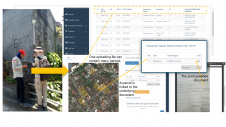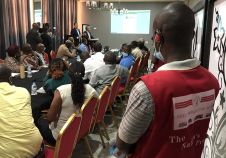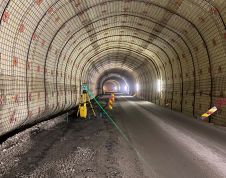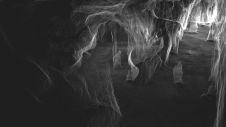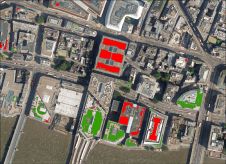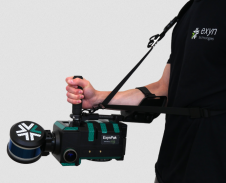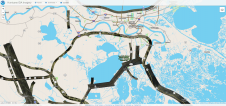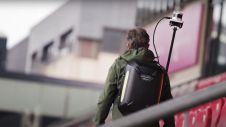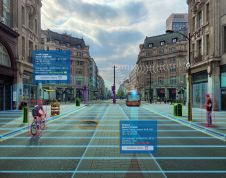Lidar Reveals Lost Roman Road from Chichester to Arundel
This article was originally published inGeomatics World.
Analysis of lidar and aerial photography by Simon Crutchley and Fiona Small, both of Historic England, has led to the rediscovery of a long-speculated route in Roman times.
The success of the Roman Empire was founded on its network of trunk and secondary roads linking centres of military or commercial importance. Chichester (Noviomagus Reginorum) on the south coast of England was a significant early settlement and developed into an important town and gateway port. A number of arterial roads headed inland and along the coast. Four of these have been identified, but the course of the road eastwards along the coastal plain has remained elusive.
Seeing under the trees
A recent aerial survey by Historic England for the Secrets of the High Woods Project (SHW and working in partnership with the South Downs National Park) has now firmly identified the remains of this Roman road. The discovery depended upon aerial photography and lidar data; the latter technique’s great strength is its potential to reveal sites in heavily-wooded areas.
The SHW project was established by the South Downs National Park and funded by The Heritage Lottery Fund, with support from Chichester District Council and English Heritage. A core element of the project was the analysis of lidar data to investigate and interpret archaeological remains surviving beneath the woodland canopy on the South Downs.
激光雷达数据收集
Lidar was commissioned from Fugro BV, who flew the survey at an altitude of approximately 710 metres AGL. This allowed for the capture of a minimum point density of approximately 10 points per m² over the project area. The vertical accuracy was equal to or better than ±15cm and horizontal accuracy equal to or better than ±20cm. The laser scanner used was a Riegl Litemapper 6800 sensor with a pulse repetition rate of up to 400,000Hz and full waveform digitisation. Navigation was carried out using dedicated flight navigation software, which uses GPS to aid the pilot in following the planned flight lines. Data were gridded to 25cm.
尽管机载激光雷达是一种相对较新的工具or archaeological survey (Crutchley & Crow 2010) since its initial use in the UK its application has expanded enormously, not least due to the availability of freely accessible data from the Environment Agency (EA), the UK Agency tasked with the protection and improvement of the environment. This data has been available for free since September 2015 and has seen an explosion in use for archaeological investigation. However, the EA data is collected for a specific purpose, and as such the resolution and the date of capture are not always appropriate for archaeological purposes, hence the need for specifically targeted flights such as those over the South Downs.
Flexible Visualisation
In parallel with the accessibility of the data there has been a major development in the use of different visualisations. In the early years of lidar archaeological research, a standard single hill-shaded image was the normal and often only visualisation used. There are obvious problems with such visualisations, primarily the fact that any features that lie parallel to the light source are rendered practically invisible. This was recognised by archaeologists many years ago because they were used to the same problem with traditional aerial photographs, where low slanting sunlight in the morning or evening is used to highlight subtle earthworks. The beauty of lidar was that we were no longer restricted to having the sun coming from the south, but looking at lots of different individual hill-shades was not particularly efficient. Initial answers to this took the form of simple processing to create multiple hill-shades using image processing software. As more archaeologists familiar with GIS processing recognised the problem they in turn developed more complex algorithms and also took advantage of work by others who needed visualisations for non-archaeological practices.
The data used in the SHW project was run remotely over the web, with some of the visualisations most commonly used by archaeologists created. Data was provided as both a DSM, for examining areas outside the woodland, and as multiple visualisations that manipulated the lidar DTM data to maximise the visibility of archaeological features that could then be viewed interactively in a pseudo-3D environment.
These visualisations included a multiple hill-shaded visualisation, where the ground surface is lit from multiple directions. This was arguably the most readily understandable visualisation as it was a familiar view for those used to viewing archaeological earthworks in 3D – usually by using a stereoscope to view stereo pairs of aerial photographs, lit naturally by the sun. The realistic height representations of a DTM make them easy for the human eye to interpret – as mounds or hollows. However, a potential weakness of the hill-shaded DTM is that the apparent position of features can move slightly from their true ground position as the direction of illumination is altered.
Local Relief Modelling
The main visualisation used for mapping archaeological features was the Local Relief Model (LRM), which isolates subtle local elevation changes from the large-scale global relief and therefore enhances the visibility of small-scale, shallow topographic features irrespective of the chosen illumination angle (Hesse 2010).
The data processing involved in the LRM allowed the regular patterning of the very low earthworks banks (also very hard to see on the ground) to be visualised and therefore recognised and plotted. In contrast, a major issue with the LRM was that for large-scale earthworks it tended to polarise the visualisation into white (upstanding banks) and black (negative hollows). Therefore, single-sided scarps such as terraces or quarry faces were often visualised as both black and white thus giving a false impression of the topography; - ‘phantom’ banks might also be haloed around negative features such as extractive pits and ‘phantom’ ditches around positive features such as barrows. The other visualisations were therefore essential for additional clarification of the true form of the features.
Openness
Two other visualisations (not illustrated) were provided - Openness-positive and Openness-negative. In contrast to the other various shading techniques, openness is not subject to a directional bias due to the angle of hill-shading and therefore relief features do not contain any false horizontal displacement. Additionally, it offers a distinction between archaeological relief features and the surrounding natural topography (Doneus 2013).
The openness techniques highlight both the highest and lowest parts of features and the resulting visualisations clearly accentuate positive features (within Openness negative) and negative features (within Openness-positive). Whilst the openness visualisations were ideal for mapping and outlining archaeological features with sharp edges such as extractive pits, the rendering of the digital models could make them difficult to interpret with slight earthworks obscured by the background pattern of the model.
The technical aspects of different lidar visualisation techniques are discussed elsewhere (Doneus 2013, Kokalj & Hesse 2017) but the key factor is to use them together to better understand the form and extent of the archaeological remains. This is particularly the case in woodland when they are the sole source of information for desk-based assessment. Aerial photographs can be compared with lidar data of non-wooded areas to inform interpretation and provide supplementary information such as evidence of buried remains, as cropmarks.
Quality Endures
Roman roads were expertly surveyed and engineered, taking the shortest possible route the terrain allowed. Even in the provinces, roads were frequently solidly constructed, featuring a cambered and metalled causeway known as an agger, typically 4.5-7m (and occasionally up to 10m) wide, and flanked by side ditches which provided drainage as well as being a source of the material used to build the road (Margary 1965, 15). The quality of their construction has ensured the survival of many stretches of Roman road to the present day and this preservation has meant that they have proven to be a particularly susceptible to recording from lidar. There have already been several examples of recoding Roman roads from the north of the country (https://www.gov.uk/government/news/lasers-reveal-lost-roman-roads), but this was a new example from the south. Unlike many of the other examples it also did not rely entirely on lidar. Traditional aerial photography also revealed some elements of the road as cropmarks, changes in vegetation caused by the underlying archaeological remains.
Speculations
Ivan Margary was one of the 20th century’s leading authorities on Roman roads. As well as undertaking extensive research of his own, Margary also generously funded excavation and publication by others; and he secured the preservation of the Roman palace of Fishbourne. His Roman Roads in Britain, first published in 1955, was the first definitive catalogue of all the major and minor Roman roads throughout the country. The maps it contained showed surviving, inferred and conjectured routes, each of which was allocated a unique number, now generally referred to as a ‘Margary number’. Some of these routes were based on earthwork remains or alignments of current roads and boundaries, but others were more speculative.
The Roman town of Noviomagus Reginorum, modern Chichester, lay at the junction of a number of roads leading north-east through the South Downs to London (Londinium), north to Silchester (Calleva), west along the coastal strip towards Bitterne (Clausentum) and due south to the coast (Margary 1955, 29-30).
Logically, as Margary speculated in the late 1940s, a fifth road should run eastward along the coastal plain in the direction of Brighton, via Arundel (Margary 1947, 141). However, unlike the course of the other roads, for which there was some evidence, the route of the road east remained speculative. In spite of this Margary published a confirmed route of the western section of the road heading eastwards from Chichester in the direction of Brighton (Margary 153) in Roman Roads in Britain (Margary 1955, 68), a situation that remained unchanged in subsequent revisions.
The Evidence Revealed
During the recent Historic England survey for the South Downs National Park, significant sections of the road’s agger and side ditches were seen as earthworks and cropmarks on aerial photographs and lidar data. Traces of the road were identified over 8km of the total 15km distance between Chichester and Arundel.
The discovery of the road is important, putting into context the Roman-era sites along its route. It is a small but significant addition to our knowledge of Roman Britain. It is also immensely satisfying to be able to confirm Ivan Margary’s theory through methods of remote sensing that would have been unimaginable sixty years ago.
For further details of the archaeology and the precise evidence for different sections of the road see Small 2017. For more on the Secrets of the High Woods project visit: www.southdowns.gov.uk/discover/heritage/secrets-of-the-high-woods/
References
Crutchley, S & Crow, P 2010 The light fantastic: Using airborne lidar in archaeological survey. English Heritage, Swindon
Doneus, M 2013. Openness as Visualization Technique for Interpretative Mapping of Airborne Lidar Derived Digital Terrain Models Remote Sensing 5 6427-6442 (2013) DOI: 10.3390/rs5126427.
Hesse, R. 2010 LiDAR-derived Local Relief Models – a new tool for archaeological prospection. Archaeological Prospection 17 67–72 (2010). DOI:10.1002/arp.374
Kokalj, Ž & Hesse, R 2017 Airborne laser scanning raster data visualization. A Guide to Good Practice Institute of Anthropological and Spatial Studies Ljubljana
Margary, I.D. 1973 Roman Roads in Britain 3rd edition, John Baker, London
Small, F 2017 The lost Roman road from Chichester to Arundel Historic England Research Issue 4: Winter 2016-17 3-8
This article was published in Geomatics World September/October 2017
Make your inbox more interesting.Add some geo.
Keep abreast of news, developments and technological advancement in the geomatics industry.
Sign up for free












